Canadian Youth Criminal Justice Act: An In-Depth Analysis
VerifiedAdded on 2023/06/12
|8
|2117
|446
Essay
AI Summary
This essay provides an in-depth analysis of the Youth Criminal Justice Act in Canada, examining its effectiveness and relevance in addressing youth crime. It begins with an overview of the Act, defining youth under its jurisdiction and outlining its objectives to protect aggrieved parties and offer young offenders a chance for rehabilitation. The essay explores public perception, noting that a significant portion of Canadian residents express distrust in the Act's functionality due to concerns about rising youth crime. It also delves into the debate over involving the legal system in youth crime cases, with many believing that parents and community members are better suited to address these issues. The research plan involves utilizing the Youth Criminal Justice Act, Juvenile Delinquents Act, and interviews with juvenile offenders to assess the Act's impact and effectiveness, concluding that the Act may need modifications to align with public sentiment and improve its perceived reliability. Desklib provides this essay as well as a wealth of other resources including past papers and solved assignments to aid students in their studies.

INTERNATIONAL AND
CANADIAN LAW
Table of Content
CANADIAN LAW
Table of Content
Paraphrase This Document
Need a fresh take? Get an instant paraphrase of this document with our AI Paraphraser

s
REFERENCES...........................................................................................................................8
REFERENCES...........................................................................................................................8
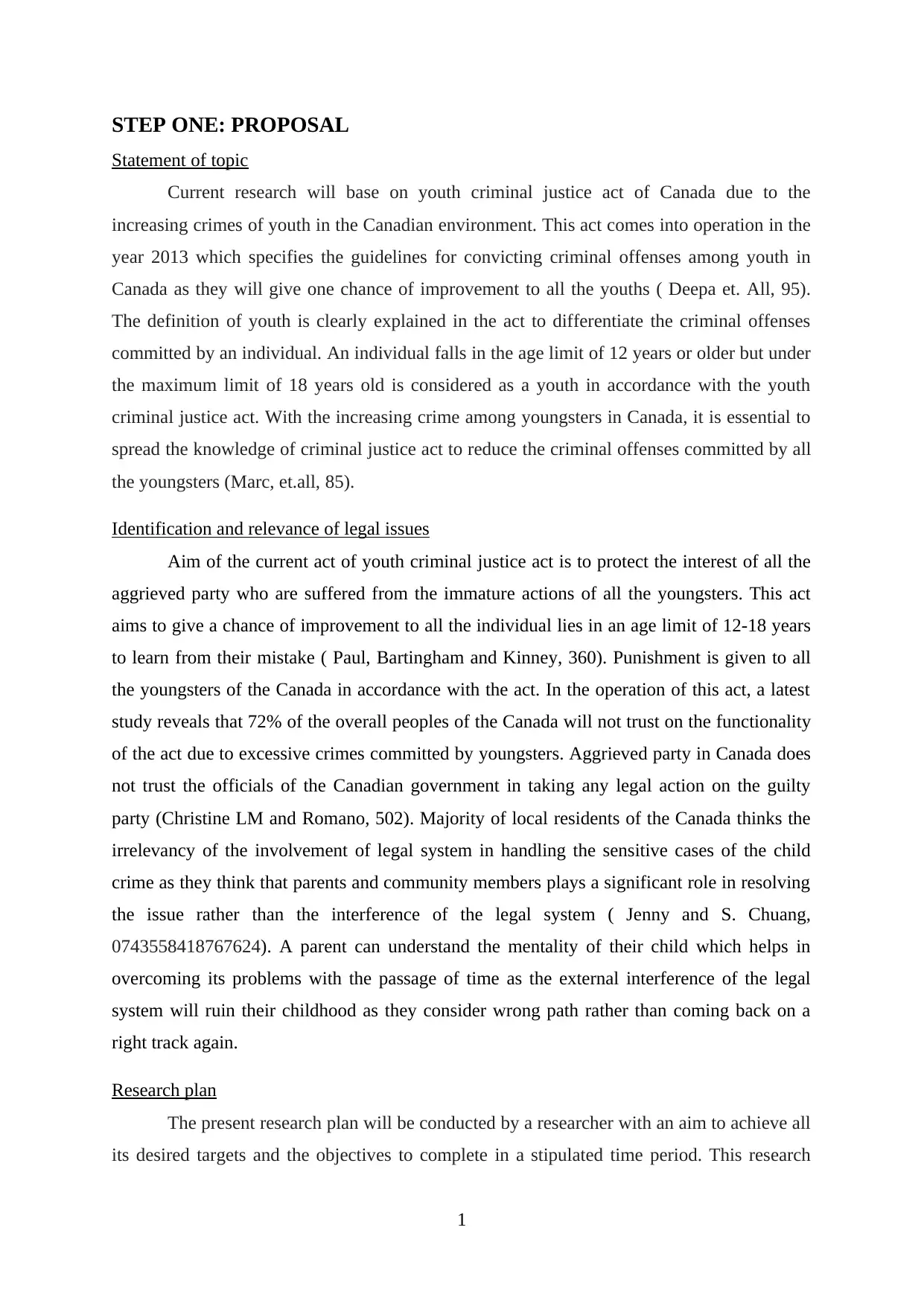
STEP ONE: PROPOSAL
Statement of topic
Current research will base on youth criminal justice act of Canada due to the
increasing crimes of youth in the Canadian environment. This act comes into operation in the
year 2013 which specifies the guidelines for convicting criminal offenses among youth in
Canada as they will give one chance of improvement to all the youths ( Deepa et. All, 95).
The definition of youth is clearly explained in the act to differentiate the criminal offenses
committed by an individual. An individual falls in the age limit of 12 years or older but under
the maximum limit of 18 years old is considered as a youth in accordance with the youth
criminal justice act. With the increasing crime among youngsters in Canada, it is essential to
spread the knowledge of criminal justice act to reduce the criminal offenses committed by all
the youngsters (Marc, et.all, 85).
Identification and relevance of legal issues
Aim of the current act of youth criminal justice act is to protect the interest of all the
aggrieved party who are suffered from the immature actions of all the youngsters. This act
aims to give a chance of improvement to all the individual lies in an age limit of 12-18 years
to learn from their mistake ( Paul, Bartingham and Kinney, 360). Punishment is given to all
the youngsters of the Canada in accordance with the act. In the operation of this act, a latest
study reveals that 72% of the overall peoples of the Canada will not trust on the functionality
of the act due to excessive crimes committed by youngsters. Aggrieved party in Canada does
not trust the officials of the Canadian government in taking any legal action on the guilty
party (Christine LM and Romano, 502). Majority of local residents of the Canada thinks the
irrelevancy of the involvement of legal system in handling the sensitive cases of the child
crime as they think that parents and community members plays a significant role in resolving
the issue rather than the interference of the legal system ( Jenny and S. Chuang,
0743558418767624). A parent can understand the mentality of their child which helps in
overcoming its problems with the passage of time as the external interference of the legal
system will ruin their childhood as they consider wrong path rather than coming back on a
right track again.
Research plan
The present research plan will be conducted by a researcher with an aim to achieve all
its desired targets and the objectives to complete in a stipulated time period. This research
1
Statement of topic
Current research will base on youth criminal justice act of Canada due to the
increasing crimes of youth in the Canadian environment. This act comes into operation in the
year 2013 which specifies the guidelines for convicting criminal offenses among youth in
Canada as they will give one chance of improvement to all the youths ( Deepa et. All, 95).
The definition of youth is clearly explained in the act to differentiate the criminal offenses
committed by an individual. An individual falls in the age limit of 12 years or older but under
the maximum limit of 18 years old is considered as a youth in accordance with the youth
criminal justice act. With the increasing crime among youngsters in Canada, it is essential to
spread the knowledge of criminal justice act to reduce the criminal offenses committed by all
the youngsters (Marc, et.all, 85).
Identification and relevance of legal issues
Aim of the current act of youth criminal justice act is to protect the interest of all the
aggrieved party who are suffered from the immature actions of all the youngsters. This act
aims to give a chance of improvement to all the individual lies in an age limit of 12-18 years
to learn from their mistake ( Paul, Bartingham and Kinney, 360). Punishment is given to all
the youngsters of the Canada in accordance with the act. In the operation of this act, a latest
study reveals that 72% of the overall peoples of the Canada will not trust on the functionality
of the act due to excessive crimes committed by youngsters. Aggrieved party in Canada does
not trust the officials of the Canadian government in taking any legal action on the guilty
party (Christine LM and Romano, 502). Majority of local residents of the Canada thinks the
irrelevancy of the involvement of legal system in handling the sensitive cases of the child
crime as they think that parents and community members plays a significant role in resolving
the issue rather than the interference of the legal system ( Jenny and S. Chuang,
0743558418767624). A parent can understand the mentality of their child which helps in
overcoming its problems with the passage of time as the external interference of the legal
system will ruin their childhood as they consider wrong path rather than coming back on a
right track again.
Research plan
The present research plan will be conducted by a researcher with an aim to achieve all
its desired targets and the objectives to complete in a stipulated time period. This research
1
⊘ This is a preview!⊘
Do you want full access?
Subscribe today to unlock all pages.

Trusted by 1+ million students worldwide
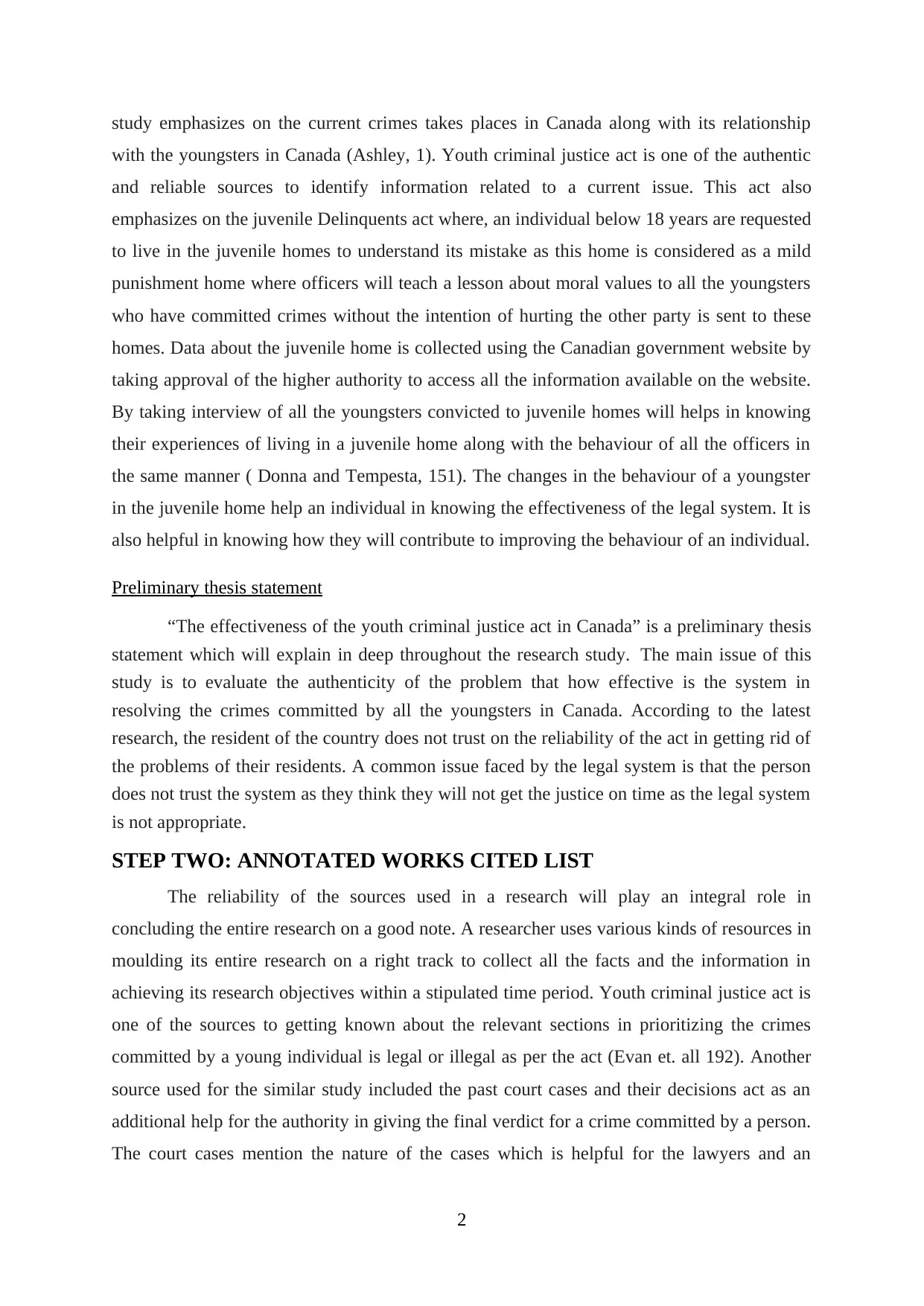
study emphasizes on the current crimes takes places in Canada along with its relationship
with the youngsters in Canada (Ashley, 1). Youth criminal justice act is one of the authentic
and reliable sources to identify information related to a current issue. This act also
emphasizes on the juvenile Delinquents act where, an individual below 18 years are requested
to live in the juvenile homes to understand its mistake as this home is considered as a mild
punishment home where officers will teach a lesson about moral values to all the youngsters
who have committed crimes without the intention of hurting the other party is sent to these
homes. Data about the juvenile home is collected using the Canadian government website by
taking approval of the higher authority to access all the information available on the website.
By taking interview of all the youngsters convicted to juvenile homes will helps in knowing
their experiences of living in a juvenile home along with the behaviour of all the officers in
the same manner ( Donna and Tempesta, 151). The changes in the behaviour of a youngster
in the juvenile home help an individual in knowing the effectiveness of the legal system. It is
also helpful in knowing how they will contribute to improving the behaviour of an individual.
Preliminary thesis statement
“The effectiveness of the youth criminal justice act in Canada” is a preliminary thesis
statement which will explain in deep throughout the research study. The main issue of this
study is to evaluate the authenticity of the problem that how effective is the system in
resolving the crimes committed by all the youngsters in Canada. According to the latest
research, the resident of the country does not trust on the reliability of the act in getting rid of
the problems of their residents. A common issue faced by the legal system is that the person
does not trust the system as they think they will not get the justice on time as the legal system
is not appropriate.
STEP TWO: ANNOTATED WORKS CITED LIST
The reliability of the sources used in a research will play an integral role in
concluding the entire research on a good note. A researcher uses various kinds of resources in
moulding its entire research on a right track to collect all the facts and the information in
achieving its research objectives within a stipulated time period. Youth criminal justice act is
one of the sources to getting known about the relevant sections in prioritizing the crimes
committed by a young individual is legal or illegal as per the act (Evan et. all 192). Another
source used for the similar study included the past court cases and their decisions act as an
additional help for the authority in giving the final verdict for a crime committed by a person.
The court cases mention the nature of the cases which is helpful for the lawyers and an
2
with the youngsters in Canada (Ashley, 1). Youth criminal justice act is one of the authentic
and reliable sources to identify information related to a current issue. This act also
emphasizes on the juvenile Delinquents act where, an individual below 18 years are requested
to live in the juvenile homes to understand its mistake as this home is considered as a mild
punishment home where officers will teach a lesson about moral values to all the youngsters
who have committed crimes without the intention of hurting the other party is sent to these
homes. Data about the juvenile home is collected using the Canadian government website by
taking approval of the higher authority to access all the information available on the website.
By taking interview of all the youngsters convicted to juvenile homes will helps in knowing
their experiences of living in a juvenile home along with the behaviour of all the officers in
the same manner ( Donna and Tempesta, 151). The changes in the behaviour of a youngster
in the juvenile home help an individual in knowing the effectiveness of the legal system. It is
also helpful in knowing how they will contribute to improving the behaviour of an individual.
Preliminary thesis statement
“The effectiveness of the youth criminal justice act in Canada” is a preliminary thesis
statement which will explain in deep throughout the research study. The main issue of this
study is to evaluate the authenticity of the problem that how effective is the system in
resolving the crimes committed by all the youngsters in Canada. According to the latest
research, the resident of the country does not trust on the reliability of the act in getting rid of
the problems of their residents. A common issue faced by the legal system is that the person
does not trust the system as they think they will not get the justice on time as the legal system
is not appropriate.
STEP TWO: ANNOTATED WORKS CITED LIST
The reliability of the sources used in a research will play an integral role in
concluding the entire research on a good note. A researcher uses various kinds of resources in
moulding its entire research on a right track to collect all the facts and the information in
achieving its research objectives within a stipulated time period. Youth criminal justice act is
one of the sources to getting known about the relevant sections in prioritizing the crimes
committed by a young individual is legal or illegal as per the act (Evan et. all 192). Another
source used for the similar study included the past court cases and their decisions act as an
additional help for the authority in giving the final verdict for a crime committed by a person.
The court cases mention the nature of the cases which is helpful for the lawyers and an
2
Paraphrase This Document
Need a fresh take? Get an instant paraphrase of this document with our AI Paraphraser

individual to compare its actual case with the past case to appeal for a low punishment. The
intention of a youngster is also considered while giving the final verdict of the act as there
two kinds of mistakes such as intentional as well as un-intentional mistakes committed by a
user.
STEP THREE: RESEARCH NOTES
Research notes play an important role in conducting a particular research as it helps
an individual in performing its research in a systematic order by completing the entire step in
the desired order. Research notes include a rough idea about the pre-completion of the
research as a researcher will note down all the sources from which they collect the facts and
the information to support its overall research study. A scrutinizer will mention the sources
from which they have to collect the information and then arrange the collected data in
forming a report to deliver the completed report to its end users (Darrel, 9). The expectations
of the final clients depend on the action of a researcher that collects reliable facts to the
research. The collected information is reviewed by them by taking the interview of all the
parties associated with a research to judge its authenticity.
STEP FOUR: ESSAY OUTLINE
Above research is based on the crimes committed by youngsters in Canada by
explaining its relevancy in front of its external users of the overall research. It is concluded
from the above research that youth criminal justice act needs to be modified according to the
views of the local residents of Canada. This will also help in spreading the knowledge about
the legal act among people.
STEP FIVE: ESSAY- ROUGH DRAFT
The main point of the essay is included in this step which helps a speaker to pick the
most suitable while presenting the same in public. Primary points of the above research
include the introduction of the youth criminal justice act, relevance of the act in Canada, legal
cases and their verdict used as an additional help to an individual, perspectives of Canadian
residents towards this act, favourable and unfavourable arguments on youth criminal justice
act.
STEP SIX: ESSAY- FINAL COPY
Youth criminal justice act
3
intention of a youngster is also considered while giving the final verdict of the act as there
two kinds of mistakes such as intentional as well as un-intentional mistakes committed by a
user.
STEP THREE: RESEARCH NOTES
Research notes play an important role in conducting a particular research as it helps
an individual in performing its research in a systematic order by completing the entire step in
the desired order. Research notes include a rough idea about the pre-completion of the
research as a researcher will note down all the sources from which they collect the facts and
the information to support its overall research study. A scrutinizer will mention the sources
from which they have to collect the information and then arrange the collected data in
forming a report to deliver the completed report to its end users (Darrel, 9). The expectations
of the final clients depend on the action of a researcher that collects reliable facts to the
research. The collected information is reviewed by them by taking the interview of all the
parties associated with a research to judge its authenticity.
STEP FOUR: ESSAY OUTLINE
Above research is based on the crimes committed by youngsters in Canada by
explaining its relevancy in front of its external users of the overall research. It is concluded
from the above research that youth criminal justice act needs to be modified according to the
views of the local residents of Canada. This will also help in spreading the knowledge about
the legal act among people.
STEP FIVE: ESSAY- ROUGH DRAFT
The main point of the essay is included in this step which helps a speaker to pick the
most suitable while presenting the same in public. Primary points of the above research
include the introduction of the youth criminal justice act, relevance of the act in Canada, legal
cases and their verdict used as an additional help to an individual, perspectives of Canadian
residents towards this act, favourable and unfavourable arguments on youth criminal justice
act.
STEP SIX: ESSAY- FINAL COPY
Youth criminal justice act
3
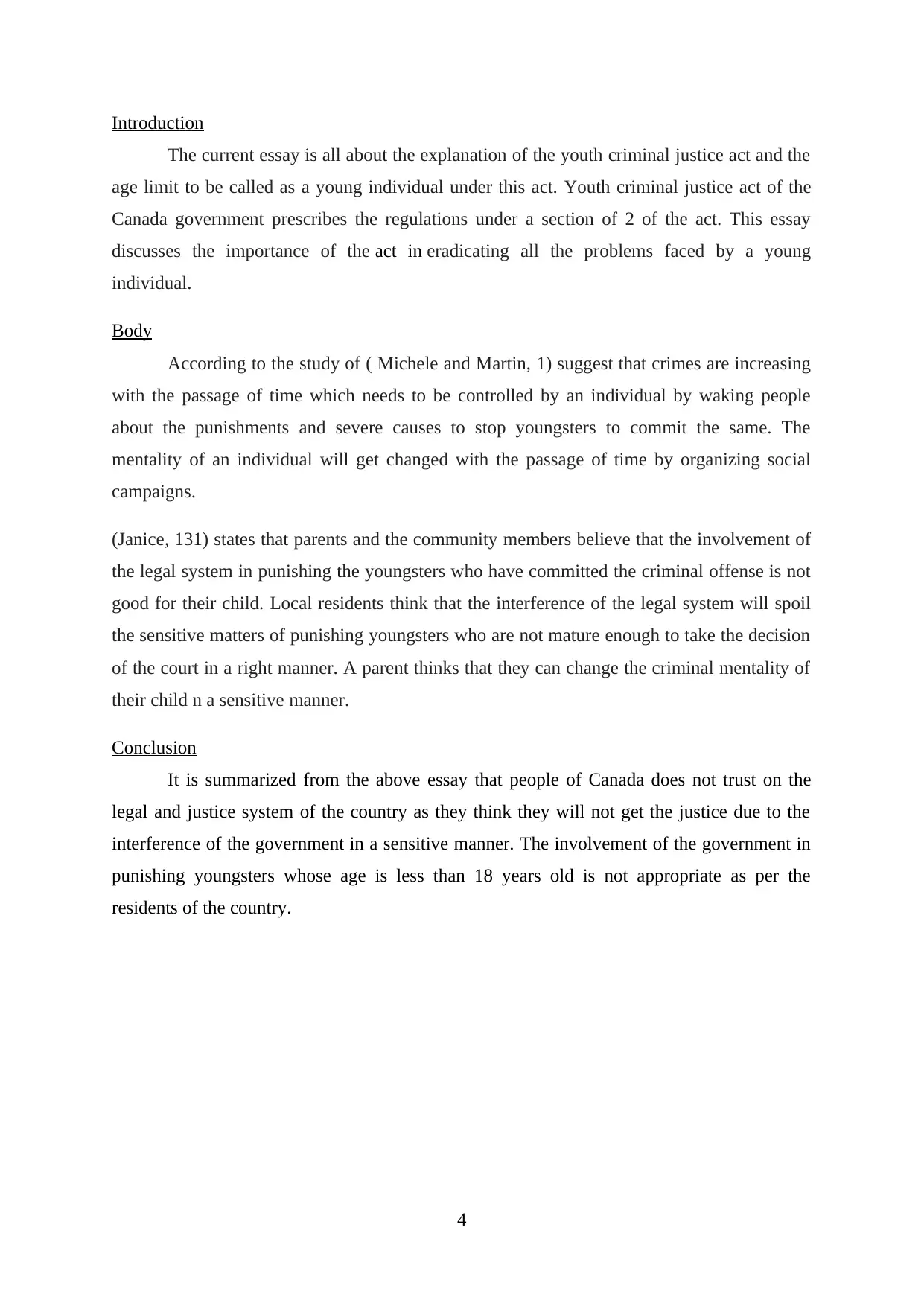
Introduction
The current essay is all about the explanation of the youth criminal justice act and the
age limit to be called as a young individual under this act. Youth criminal justice act of the
Canada government prescribes the regulations under a section of 2 of the act. This essay
discusses the importance of the act in eradicating all the problems faced by a young
individual.
Body
According to the study of ( Michele and Martin, 1) suggest that crimes are increasing
with the passage of time which needs to be controlled by an individual by waking people
about the punishments and severe causes to stop youngsters to commit the same. The
mentality of an individual will get changed with the passage of time by organizing social
campaigns.
(Janice, 131) states that parents and the community members believe that the involvement of
the legal system in punishing the youngsters who have committed the criminal offense is not
good for their child. Local residents think that the interference of the legal system will spoil
the sensitive matters of punishing youngsters who are not mature enough to take the decision
of the court in a right manner. A parent thinks that they can change the criminal mentality of
their child n a sensitive manner.
Conclusion
It is summarized from the above essay that people of Canada does not trust on the
legal and justice system of the country as they think they will not get the justice due to the
interference of the government in a sensitive manner. The involvement of the government in
punishing youngsters whose age is less than 18 years old is not appropriate as per the
residents of the country.
4
The current essay is all about the explanation of the youth criminal justice act and the
age limit to be called as a young individual under this act. Youth criminal justice act of the
Canada government prescribes the regulations under a section of 2 of the act. This essay
discusses the importance of the act in eradicating all the problems faced by a young
individual.
Body
According to the study of ( Michele and Martin, 1) suggest that crimes are increasing
with the passage of time which needs to be controlled by an individual by waking people
about the punishments and severe causes to stop youngsters to commit the same. The
mentality of an individual will get changed with the passage of time by organizing social
campaigns.
(Janice, 131) states that parents and the community members believe that the involvement of
the legal system in punishing the youngsters who have committed the criminal offense is not
good for their child. Local residents think that the interference of the legal system will spoil
the sensitive matters of punishing youngsters who are not mature enough to take the decision
of the court in a right manner. A parent thinks that they can change the criminal mentality of
their child n a sensitive manner.
Conclusion
It is summarized from the above essay that people of Canada does not trust on the
legal and justice system of the country as they think they will not get the justice due to the
interference of the government in a sensitive manner. The involvement of the government in
punishing youngsters whose age is less than 18 years old is not appropriate as per the
residents of the country.
4
⊘ This is a preview!⊘
Do you want full access?
Subscribe today to unlock all pages.

Trusted by 1+ million students worldwide
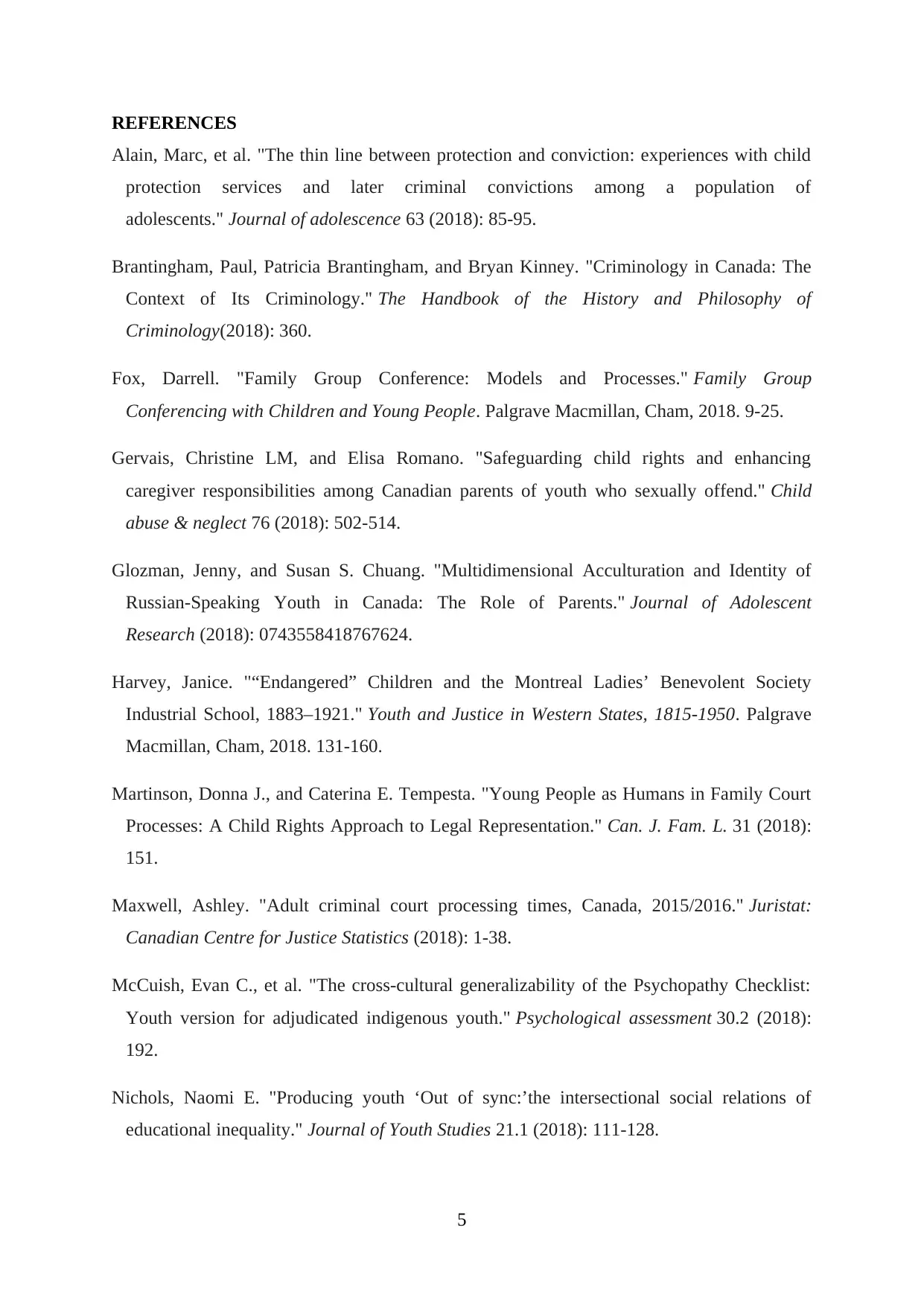
REFERENCES
Alain, Marc, et al. "The thin line between protection and conviction: experiences with child
protection services and later criminal convictions among a population of
adolescents." Journal of adolescence 63 (2018): 85-95.
Brantingham, Paul, Patricia Brantingham, and Bryan Kinney. "Criminology in Canada: The
Context of Its Criminology." The Handbook of the History and Philosophy of
Criminology(2018): 360.
Fox, Darrell. "Family Group Conference: Models and Processes." Family Group
Conferencing with Children and Young People. Palgrave Macmillan, Cham, 2018. 9-25.
Gervais, Christine LM, and Elisa Romano. "Safeguarding child rights and enhancing
caregiver responsibilities among Canadian parents of youth who sexually offend." Child
abuse & neglect 76 (2018): 502-514.
Glozman, Jenny, and Susan S. Chuang. "Multidimensional Acculturation and Identity of
Russian-Speaking Youth in Canada: The Role of Parents." Journal of Adolescent
Research (2018): 0743558418767624.
Harvey, Janice. "“Endangered” Children and the Montreal Ladies’ Benevolent Society
Industrial School, 1883–1921." Youth and Justice in Western States, 1815-1950. Palgrave
Macmillan, Cham, 2018. 131-160.
Martinson, Donna J., and Caterina E. Tempesta. "Young People as Humans in Family Court
Processes: A Child Rights Approach to Legal Representation." Can. J. Fam. L. 31 (2018):
151.
Maxwell, Ashley. "Adult criminal court processing times, Canada, 2015/2016." Juristat:
Canadian Centre for Justice Statistics (2018): 1-38.
McCuish, Evan C., et al. "The cross-cultural generalizability of the Psychopathy Checklist:
Youth version for adjudicated indigenous youth." Psychological assessment 30.2 (2018):
192.
Nichols, Naomi E. "Producing youth ‘Out of sync:’the intersectional social relations of
educational inequality." Journal of Youth Studies 21.1 (2018): 111-128.
5
Alain, Marc, et al. "The thin line between protection and conviction: experiences with child
protection services and later criminal convictions among a population of
adolescents." Journal of adolescence 63 (2018): 85-95.
Brantingham, Paul, Patricia Brantingham, and Bryan Kinney. "Criminology in Canada: The
Context of Its Criminology." The Handbook of the History and Philosophy of
Criminology(2018): 360.
Fox, Darrell. "Family Group Conference: Models and Processes." Family Group
Conferencing with Children and Young People. Palgrave Macmillan, Cham, 2018. 9-25.
Gervais, Christine LM, and Elisa Romano. "Safeguarding child rights and enhancing
caregiver responsibilities among Canadian parents of youth who sexually offend." Child
abuse & neglect 76 (2018): 502-514.
Glozman, Jenny, and Susan S. Chuang. "Multidimensional Acculturation and Identity of
Russian-Speaking Youth in Canada: The Role of Parents." Journal of Adolescent
Research (2018): 0743558418767624.
Harvey, Janice. "“Endangered” Children and the Montreal Ladies’ Benevolent Society
Industrial School, 1883–1921." Youth and Justice in Western States, 1815-1950. Palgrave
Macmillan, Cham, 2018. 131-160.
Martinson, Donna J., and Caterina E. Tempesta. "Young People as Humans in Family Court
Processes: A Child Rights Approach to Legal Representation." Can. J. Fam. L. 31 (2018):
151.
Maxwell, Ashley. "Adult criminal court processing times, Canada, 2015/2016." Juristat:
Canadian Centre for Justice Statistics (2018): 1-38.
McCuish, Evan C., et al. "The cross-cultural generalizability of the Psychopathy Checklist:
Youth version for adjudicated indigenous youth." Psychological assessment 30.2 (2018):
192.
Nichols, Naomi E. "Producing youth ‘Out of sync:’the intersectional social relations of
educational inequality." Journal of Youth Studies 21.1 (2018): 111-128.
5
Paraphrase This Document
Need a fresh take? Get an instant paraphrase of this document with our AI Paraphraser
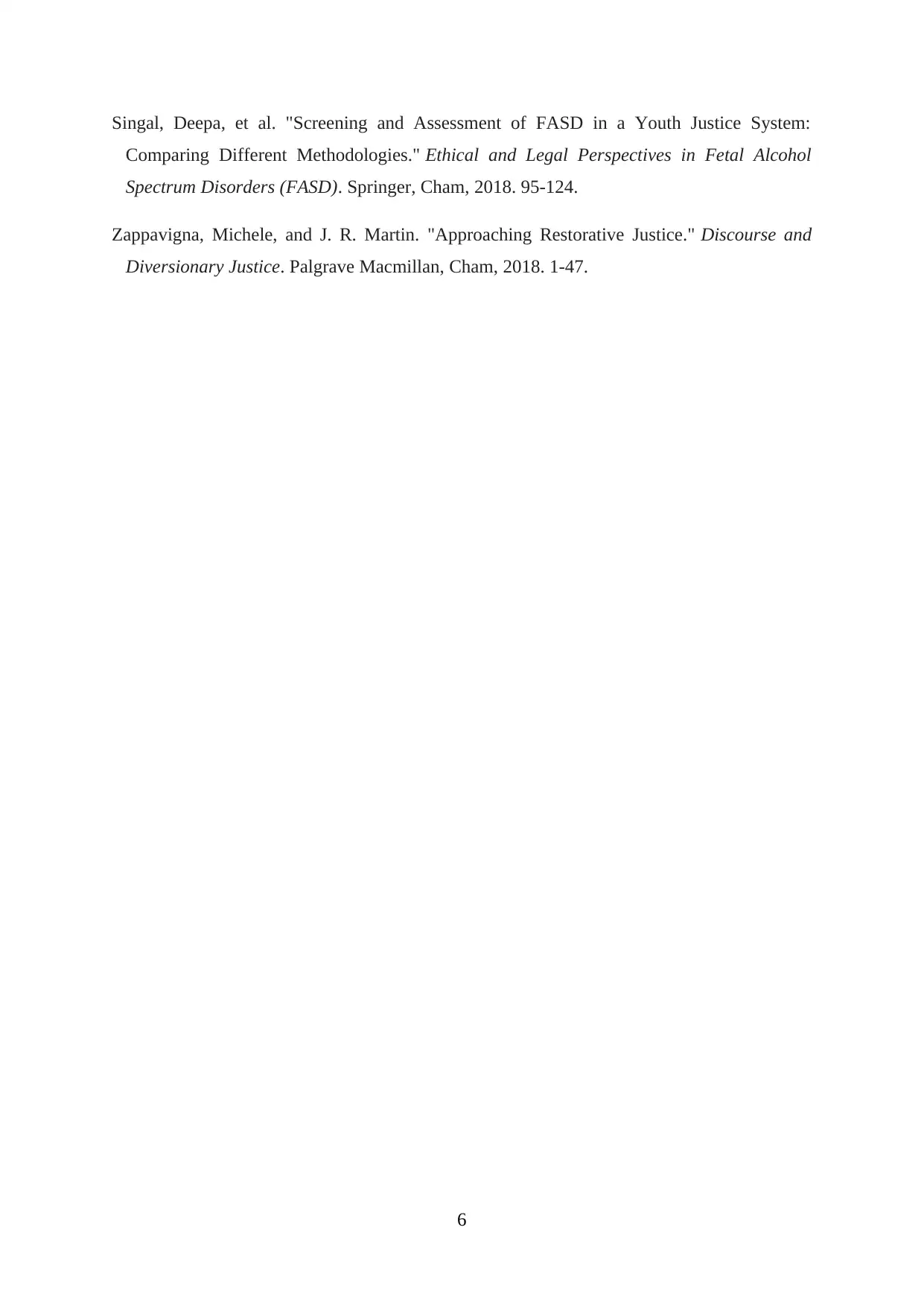
Singal, Deepa, et al. "Screening and Assessment of FASD in a Youth Justice System:
Comparing Different Methodologies." Ethical and Legal Perspectives in Fetal Alcohol
Spectrum Disorders (FASD). Springer, Cham, 2018. 95-124.
Zappavigna, Michele, and J. R. Martin. "Approaching Restorative Justice." Discourse and
Diversionary Justice. Palgrave Macmillan, Cham, 2018. 1-47.
6
Comparing Different Methodologies." Ethical and Legal Perspectives in Fetal Alcohol
Spectrum Disorders (FASD). Springer, Cham, 2018. 95-124.
Zappavigna, Michele, and J. R. Martin. "Approaching Restorative Justice." Discourse and
Diversionary Justice. Palgrave Macmillan, Cham, 2018. 1-47.
6
1 out of 8
Related Documents
Your All-in-One AI-Powered Toolkit for Academic Success.
+13062052269
info@desklib.com
Available 24*7 on WhatsApp / Email
![[object Object]](/_next/static/media/star-bottom.7253800d.svg)
Unlock your academic potential
Copyright © 2020–2025 A2Z Services. All Rights Reserved. Developed and managed by ZUCOL.





